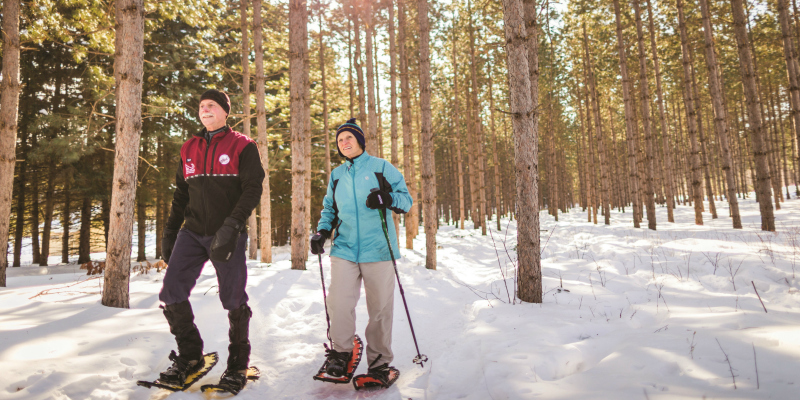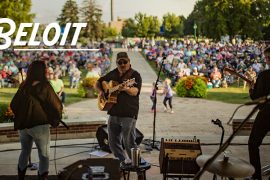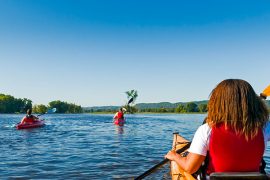By Nicole Gruter | Photos Courtesy travelwisconsin.com
My first time snowshoeing, a friend and I got lost in Wisconsin’s Chequamegon National Forest for the better part of five hours. Wearing traditional wood and rawhide snowshoes, we took turns falling over into the deep snow as eagles circled above us, seemingly scoping out their next meal. Accepting that our internal compass was broken, we reluctantly backtracked on our shoe prints, the quick sunset threatening to eclipse our next step. When we finally got back to the cabin, the owner of the land greeted us with a relieved, but memorably stern, “I was just about to come looking for you.”
Despite this not entirely successful first snowshoeing experience I became an avid fan. It keeps you active in winter, gets you outside, and best of all, you can snowshoe just about anywhere you can walk, making the possibilities endless.
With an array of modern metal frame designs available now, comfortable options suit a range of needs. The bindings are adjustable, allowing use of anything from Gore-Tex runners to Sorrel boots. If you’re craving a faster pace, running snowshoes are created with a smaller, lighter platform with crampons that bite the snow’s surface, more so than floating on top, providing greater traction.
Mary Lane, a snowshoe enthusiast and Rutabaga salesperson, encourages people to use poles along with their snowshoes. “They help with more difficult terrain, plus they increase your cardiovascular workout,” she says. Snowshoeing can burn more calories than skiing!
There are basically no rules to snowshoeing, but Lane mentions one big snow faux pas: avoid walking on groomed ski trails.
Skiers pay for groomed trails, and one tromp from a snowshoe can ruin it for them. Other signs to watch out for, like those at UW Arboretum, are there to protect animal habitat. Lane stresses, “You may be having a blast, but you might be collapsing the tunnels of animals that live under the snow; there are sensitive places in the arboretum that say ‘please do not walk here.’”
Newbies might want to first try flat terrain such as area golf courses (heads up, Odana is cross-country skiing only). Snowshoeing on the lakes is uniquely serene, just be sure to avoid areas where current is flowing, such as Frostwoods Park or Yahara Bay. The Ice Age Trail cutting through Verona and Middleton also provides easy to moderate trails.
For a day trip, Blue Mounds State Park “is popular because the topography is challenging, hilly and diverse. It’s often what people are looking for,” according to Park Ranger Brian Yanke. The park offers 15 miles of snowshoeing trails, some of which are advanced and rather remote.
Further north yet, Chippewa Moraine State Recreational Area near New Auburn encompasses part of the Ice Age Trail that loops through glacial lakes, restoration prairie land and old growth forest. The park also features an interpretive center where you can warm up while learning more about the spectacularly scenic area. Snowshoes are available to borrow with a suggested donation.
Rutabaga offers 24-hour or multiple day rental of recreational snowshoe kits which include trekking poles and shoes with simple crampons meant for rolling or flat terrain. Lane warns that rentals sell out for candlelight walks but can be reserved in advance. These walks tend to be crowded, but are lots of magical fun, often offering hot cocoa or cider.
Check the Wisconsin Department of Natural Resources website for details about candlelight hikes and many more state parks events. dnr.wi.gov/Calendar/Events/Parks/.





Comments are closed.